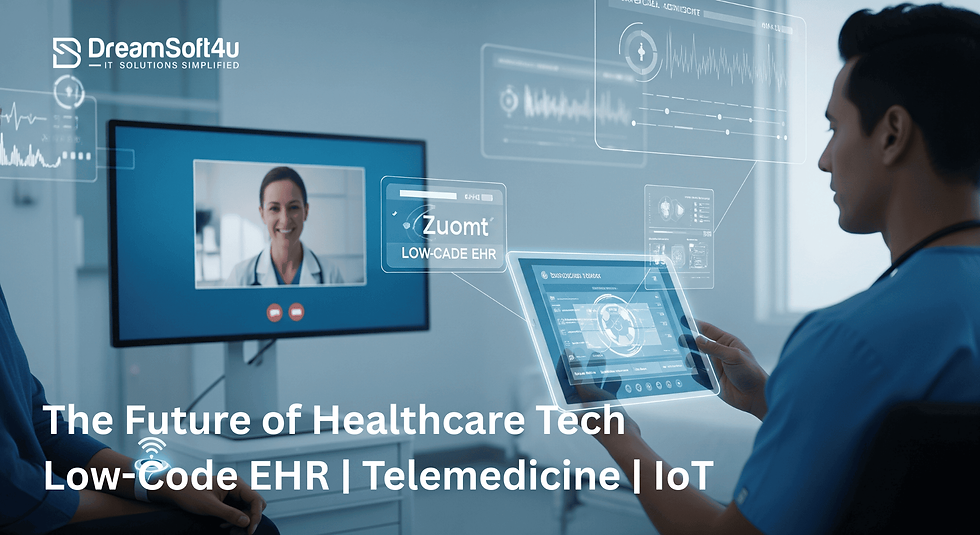Top 5 Healthcare Tech Trends for 2025: Low‑Code EHR and Augmented Teams Lead the Way
- ds4useodigital
- Aug 11, 2025
- 3 min read

The healthcare sector is experiencing a digital transformation like never before. Emerging technologies are not only reshaping the way care is delivered but are also revolutionizing the systems that power the healthcare industry. As we approach 2025, several trends are poised to make a significant impact. This blog covers the top 5 healthcare tech trends for 2025, focusing on low-code EHR solutions, IT staff augmentation services, and other innovations like AI-assisted documentation and IoT in patient monitoring. These trends are driving efficiency and transforming healthcare delivery, aligning with Google’s emphasis on helpful, people-first content.
1. The Rise of Low-Code Development Platforms in Healthcare
One of the biggest shifts in healthcare IT is the increasing adoption of low-code platforms. These platforms enable healthcare organizations to develop applications rapidly without requiring extensive coding expertise. Low-code development platforms are revolutionizing the creation of EHR solutions and other healthcare applications by simplifying the development process. They empower healthcare teams to create low-code software applications, such as patient management systems and scheduling tools, with minimal technical resources.
Why Low-Code EHR Solutions Are a Game-Changer
For years, EHR software development required large teams of highly skilled developers. Today, low-code EHR solutions are dramatically accelerating this process. With low-code tools, healthcare providers can customize EHR software and integrate features like telemedicine and mobile apps much faster than ever before. Low-code development services from companies like DreamSoft4u allow healthcare providers to build robust applications without overburdening their internal IT teams.
Low-code platforms for web development are particularly beneficial for creating user-friendly EMR software and patient portals that ensure compliance with healthcare standards. By leveraging no-code low-code platforms, even non-technical staff can participate in the application development process, streamlining the entire process. Healthcare providers can now deploy systems in weeks rather than months, reducing both the cost and time-to-market.
2. IT Staff Augmentation: Filling the Talent Gap with On-Demand Expertise
Healthcare organizations are increasingly turning to IT staff augmentation services to bridge the talent gap caused by the rapid growth of digital health technologies. With the complexity of EHR software development, healthcare providers are finding it more efficient to collaborate with staff augmentation companies that offer specialized expertise in areas like EMR solutions, integration, and cybersecurity.
IT staff augmentation agencies provide healthcare organizations with the flexibility to scale their teams quickly, bringing in experienced professionals with specific skills as needed. This model is particularly effective in managing complex projects like EHR interoperability solutions, where specialized knowledge in healthcare data standards such as HL7 and FHIR is essential.
IT Staff Augmentation for EHR Implementation and Beyond
By collaborating with an IT staff augmentation company, healthcare providers can bring in expert developers and consultants who specialize in areas such as EHR interoperability solutions and EMR software development. Companies like DreamSoft4u provide access to skilled professionals who can seamlessly integrate EHR solutions with other hospital systems, ensuring streamlined workflows and improved patient care.
3. AI-Assisted Documentation: Enhancing Efficiency and Reducing Administrative Burden
AI-assisted documentation is transforming how healthcare providers manage patient records and other documentation tasks. The use of AI tools to automate EHR software entry and medical transcription reduces the time healthcare professionals spend on administrative tasks, allowing them to focus more on patient care. By integrating AI tools with EMR software, healthcare organizations can achieve more accurate, faster documentation, improving the efficiency of both EMR solutions and EHR systems.
Key Benefits:
Time savings: Automate repetitive documentation tasks.
Improved accuracy: AI tools reduce human errors in patient records.
Enhanced patient care: With less time spent on documentation, providers can focus more on patient interactions.
Cost reduction: AI-assisted documentation can cut down on administrative overhead.
As we approach 2025, the healthcare industry is embracing a wave of digital innovations that will fundamentally transform patient care and operational efficiency. From low-code EHR solutions to IT staff augmentation services, these trends are empowering healthcare organizations to deliver faster, more personalized care while managing complex IT infrastructure. With the integration of AI, IoT, and telemedicine into the healthcare ecosystem, the future of healthcare delivery is poised to be more efficient, accessible, and patient-centric than ever before.
Embracing these technologies will enable healthcare organizations to stay competitive, reduce costs, and improve care outcomes. Whether through low-code platforms, staff augmentation solutions, or cutting-edge patient monitoring systems, the healthcare sector is set to reap the rewards of these innovations in the years to come.








API Connects is a leading IT firm in New Zealand, specializing in IoT development, IoT solutions, and data engineering services. We provide cutting-edge IoT solutions to enhance business operations and data engineering services for seamless data migration and optimization. Our expert DevOps team ensures secure core banking data migration for financial institutions. Visit- https://apiconnects.co.nz/iot-development-testing-consulting/ , https://apiconnects.co.nz/data-engineering-services/